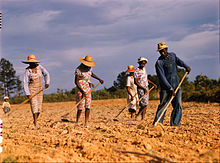Federal Writers' Project – Life Histories/2015/Fall/Section 020/Lavinia McKee
Lavinia McKee | |
|---|---|
| Born | Lavinia McKee 1876 Beaufort County, South Carolina |
| Died | 1965 Beaufort County, South Carolina |
| Occupation | Midwife and Farmer |
Overview
[edit | edit source]Lavinia McKee was an African American midwife who lived in Beaufort County, South Carolina.[1]
Biography
[edit | edit source]Early Life
[edit | edit source]Lavinia McKee was a black woman born in Beaufort County, South Carolina around 1876.[2] Both of McKee’s parents were from South Carolina and she was one of two children. Her father worked on a rice plantation on the Savannah River, and when McKee was six, he left her mother and took McKee to live with him. McKee's father raised and supported her until she was married. McKee married Paul McKee at 19.[3]
Adulthood
[edit | edit source]The McKees had three children, one girl and two boys, and continued to live in Beaufort County. They made their living by farming and renting out land that they had inherited from McKee's father (66 acres and a two story farm house). McKee became a midwife when her first and only grandson was born. Her mother and grandmother had taught her how to be a midwife when she was a young girl and she continued to be one in the area for many years. McKee raised and educated her three children (who moved to New York and New Jersey to work), grandson, and six other children that she adopted. She died in Beaufort County in 1965.[4]
Social Issues
[edit | edit source]
Midwifery
[edit | edit source]A midwife is a person who is trained to assist with childbirth.[5]In the South, midwives have traditionally been African-American. Since the early 17th century, black midwives have been assisting with the births of both white and black children in homes, especially in rural communities.[6] During slavery, owning a midwife was valuable since she could assist pregnant women before, during, and after the birth of a child as well as treat most illnesses. The master would rent out her services and she would pass her skills on to her daughters.[7] The use of black midwives during childbirth was popular because it was much cheaper than hiring a doctor to deliver a baby. Midwives were considered to have special healing powers and were very superstitious. For example, traditional midwives would immediately place a new born under a bed to make it a "good" child, or tie strings around a baby's wrists and ankles to make it stronger.[8] However, these tactics were seen as unclean and unsuccessful by medical professionals (male doctors who worked in hospitals and doctor's offices) due to high mortality rates. Therefore, laws were passed that required midwives to obtain official licenses and attend regular medical classes conducted by a public nurse.[9] By the 1940s, social childbirth (conducted in homes by midwives) had been mostly replaced by scientific childbirth in the hospital.[10]

Sharecropping
[edit | edit source]During and after the Reconstruction Era, black families would rent small areas of land to work themselves. However, they would have to give a portion of their crop to the landowner at the end of the year.[11] This was called sharecropping. This system was dominant in the south from the 1870s to about the 1950s. Some blacks were able to acquire enough money to move from sharecropping to renting or owning land by the end of the 1860s, but many went into debt. Some were even forced by poverty or fear of violence to sign unfair and exploitative labor contracts that left them little hope for a better life.[12] Sharecropping was a very exploitative system because it allowed white land owners to maintain dominance and control over the black population even though slavery had ended. The white landowner would reap the benefits of the black family's labor by receiving a portion of the harvested crops as well as the rent that he black family had to pay for the land. Debt would quickly pile up for many black families which, along with labor contracts, prevented the families from being able to leave the area and the oppressive sharecropping lifestyle. This system kept many black families in poverty and subordinate to the white landowners.[13]
Bibliography
[edit | edit source]- ↑ Lavinia McKee. Federal Writers Project, Wilson Library at the University of North Carolina at Chapel Hill.
- ↑ The Bureau of the Census; census forms; the census of 1930.
- ↑ Lavinia McKee. Federal Writers Project, Wilson Library at the University of North Carolina at Chapel Hill.
- ↑ Lavinia McKee. Federal Writers Project, Wilson Library at the University of North Carolina at Chapel Hill.
- ↑ Dictionary.com. Dictionary.com, n.d. Web. 06 Oct. 2015.
- ↑ Palmer, Colin A. Encyclopedia of African-American Culture and History, Vol. 4. 2nd ed., s.v. “Midwifery.” Detroit: Macmillan Reference USA, 2006. P1432.
- ↑ Palmer, Colin A. Encyclopedia of African-American Culture and History, Vol. 4. 2nd ed., s.v. “Midwifery.” Detroit: Macmillan Reference USA, 2006. P1432-1433.
- ↑ Lavinia Mckee. Federal Writers Project, Wilson Library at the University of North Carolina at Chapel Hill.
- ↑ Lavinia McKee. Federal Writers Project, Wilson Library at the University of North Carolina at Chapel Hill.
- ↑ Palmer, Colin A. Encyclopedia of African-American Culture and History, Vol. 4. 2nd ed., s.v. “Midwifery.” Detroit: Macmillan Reference USA, 2006. P1432.
- ↑ Staff, History.com. “Sharecropping.” History.com. 2010. October 1st 2015.http://www.history.com/topics/black-history/sharecropping.
- ↑ Staff, History.com. “Sharecropping.” History.com. 2010. October 1st 2015. http://www.history.com/topics/black-history/sharecropping.
- ↑ Staff, History.com. “Sharecropping.” History.com. 2010. October 1st 2015. http://www.history.com/topics/black-history/sharecropping
